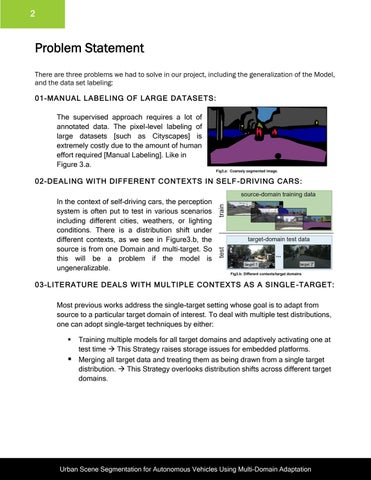2
Problem Statement There are three problems we had to solve in our project, including the generalization of the Model, and the data set labeling: 01-MANUAL LABELING OF LARGE DATASETS: The supervised approach requires a lot of annotated data. The pixel-level labeling of large datasets [such as Cityscapes] is extremely costly due to the amount of human effort required [Manual Labeling]. Like in Figure 3.a. Fig3.a: Coarsely segmented image.
02-DEALING WITH DIFFERENT CONTEXTS IN SELF -DRIVING CARS : In the context of self-driving cars, the perception system is often put to test in various scenarios including different cities, weathers, or lighting conditions. There is a distribution shift under different contexts, as we see in Figure3.b, the source is from one Domain and multi-target. So this will be a problem if the model is ungeneralizable. Fig3.b: Different contexts/target domains
03-LITERATURE DEALS WITH MULTIPLE CONTEXTS AS A SINGLE -TARGET: Most previous works address the single-target setting whose goal is to adapt from source to a particular target domain of interest. To deal with multiple test distributions, one can adopt single-target techniques by either: Training multiple models for all target domains and adaptively activating one at test time → This Strategy raises storage issues for embedded platforms. ▪ Merging all target data and treating them as being drawn from a single target distribution. → This Strategy overlooks distribution shifts across different target domains. ▪
Urban Scene Segmentation for Autonomous Vehicles Using Multi-Domain Adaptation








